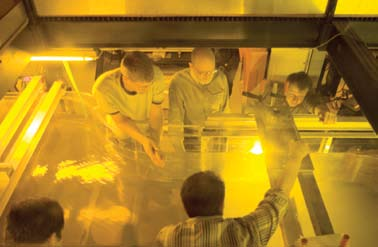A bumblebee can beat its wings 130 times a second and a hummingbird 200 times, all the while darting and accelerating as no man-made machine can.
The creatures, says Donald Rockwell, owe their aviation prowess to a common phenomenon – the ability to generate vortices from the edges of their wings.
To build micro-aerial vehicles (MAVs) that fly like an insect, bird or bat, says Rockwell, the Paul B. Reinhold Professor of mechanical engineering and mechanics, one must first understand the complex swirl patterns and fluid flows emanating from the creatures’ wings.
With a grant from the Air Force Office of Scientific Research, Rockwell and his students are simulating and evaluating real-world air-flow patterns in a 30-foot-long water channel in Lehigh’s Fluid Mechanics Lab.
In that channel, in the 1990s, Rockwell’s group became the first to employ laser-based imaging techniques and image processing to measure flow patterns quantitatively in shallow layers of water. The group places thousands of microparticles in the channel, illuminates them with dual-pulsed lasers, and uses a software program to evaluate particle vortex and velocity patterns at thousands of locations within the flow.
The water channel is an effective facility for studying vortex generation by aerial flows, says Rockwell.
“We can simulate in water the vortex patterns that are generated in air by scaling the velocity, length and viscosity from the actual wing in air to the model of the wing in water. This enables us to model vortex formation from the leading edge and tip of an MAV wing and, furthermore, to measure the lift and thrust of the wing. We accomplish this scaling by using the dimensionless Reynolds number, which is the product of velocity and length divided by viscosity.
“Our goal is to understand the superior vortex formation from the edges of wings of small flying creatures. The retention of the leading-edge vortex is closely related to maneuverability.”
Rockwell is one of two chief editors of Experiments in Fluids, an international journal that will publish special issues this year on the modeling of swimming and flying abilities of creatures.
Rockwell’s other projects include the study of fluid flows past submarine hulls, blood flow patterns around catheters, and vortex formation in shallow flows, a phenomenon that affects the control of pollutants, the health of aquatic life and vegetation, and erosion and sediment transport.

